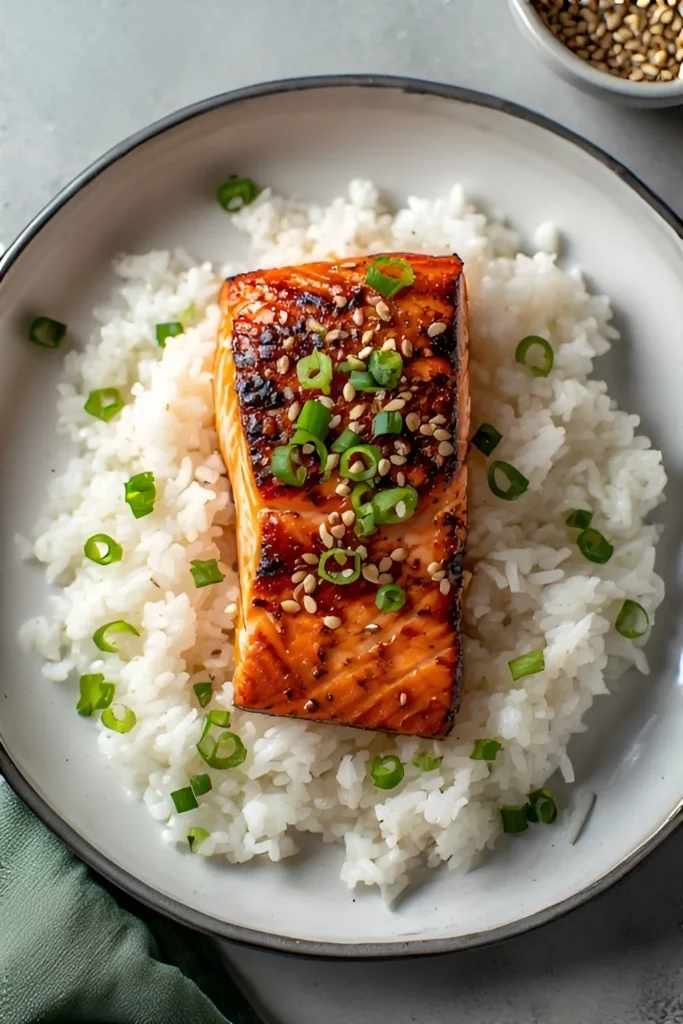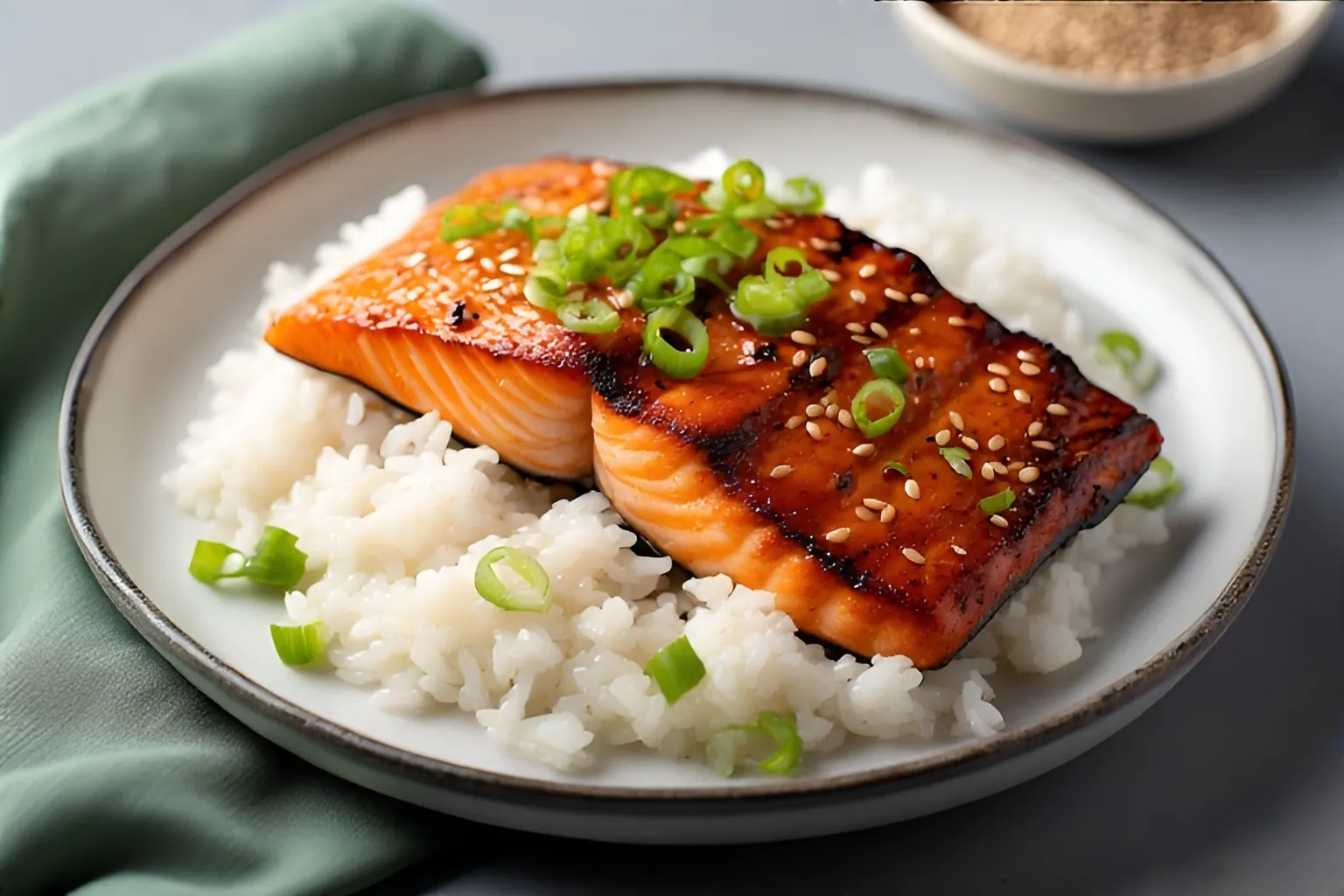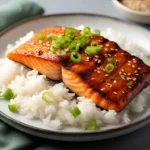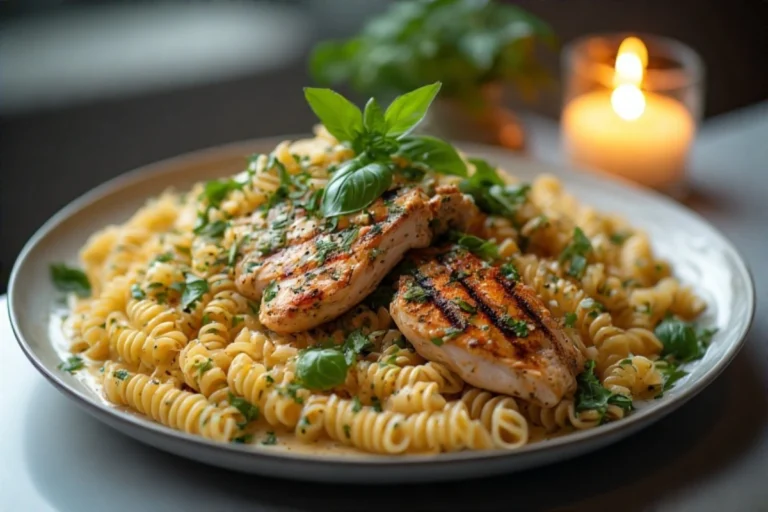Irresistible Miso Salmon Recipe You’ll Want to Make Again and Again
If you’re looking for a quick and flavorful way to enjoy salmon, this miso salmon recipe will quickly become a favorite in your kitchen. With its savory-sweet miso glaze and rich umami flavor, this dish brings restaurant-quality taste to your dinner table — no complicated prep or techniques required. Whether you’re cooking for one or preparing a special meal for guests, miso glazed salmon is the kind of dish that feels both impressive and easy.
Salmon is already a favorite for its health benefits and versatility, but when you add miso to the mix, you elevate the flavor to something truly special. Miso — a fermented soybean paste — adds depth, richness, and that distinctive umami flavor Japanese cuisine is known for. Paired with a hint of sesame and a touch of sweetness, this miso marinade transforms your salmon into a satisfying, flavorful main dish that you’ll want to make again and again.
This miso salmon recipe is ideal for weeknights thanks to its quick cook time, but it’s also elegant enough to serve for dinner parties or date night. If you’ve never tried miso marinated salmon before, you’re in for a treat — it’s a simple recipe with big flavor.
Why You’ll Love This Miso Salmon Recipe
You’re going to appreciate this miso glazed salmon for more than just its taste. It’s the kind of recipe that checks all the boxes:
- Fast & Easy: Just a few ingredients and minimal prep.
- Deep Flavor: The miso marinade infuses the salmon with umami, sweetness, and a hint of nuttiness.
- Versatile: Works well with broiling or baking, depending on the thickness of your fillets.
- Healthy: Packed with lean protein and omega-3s.
- Impressive: Feels like a restaurant dish but made entirely at home.
Whether you’re feeding your family or cooking for yourself, this recipe is one you’ll come back to often.
PrintIrresistible Miso Salmon Recipe You’ll Want to Make Again and Again
This easy miso-glazed salmon is packed with sweet and savory flavor thanks to a quick marinade using miso paste, soy sauce, and sesame oil. Broiled or baked to perfection, it delivers crispy skin and moist, tender flesh. Ideal for a weeknight dinner and pairs wonderfully with rice or steamed vegetables.
- Prep Time: 5 minutes
- Cook Time: 15 minutes
- Total Time: 20 minutes
- Yield: 2 1x
- Category: Main Course
Ingredients
Salmon:
2 skin-on salmon fillets (each 4–6 oz, total about ¾ lb)
For the Marinade:
2 tablespoons miso paste (any type)
1 tablespoon mirin
1 tablespoon soy sauce
¼ teaspoon toasted sesame oil
Optional Garnish:
½ teaspoon white and black sesame seeds
1 green onion, thinly sliced
Instructions
1. Prepare the Salmon:
Check the salmon fillets for any small bones and scales. Remove bones with tweezers and scrape off any scales using the flat edge of a knife.
2. Make the Marinade:
In a shallow dish or bowl, combine the miso paste, mirin, soy sauce, and sesame oil. Stir well.
3. Marinate the Salmon:
Place the salmon fillets skin-side up in the marinade. Spoon the marinade over to fully coat. Cover and refrigerate for 1 to 2 hours (or up to 3 hours if the fillets are thick). Avoid marinating overnight to prevent the fish from becoming too salty.
Notes
For Thin Fillets (Under 1 Inch): Broil
Preheat your oven’s broiler on high (around 550°F) and set a rack about 9 inches from the heating element.
Line a baking sheet with foil and lightly oil it.
Remove salmon from marinade and scrape off excess. Place fillets skin-side down on the sheet.
Broil for 10–13 minutes, or until the internal temperature reaches 125–130°F. No need to flip. Remove when done.
For Thick Fillets: Bake
Preheat oven to 425°F. If using a convection oven, reduce to 400°F.
Line a baking sheet with parchment. Remove excess marinade from the salmon and place skin-side down on the sheet.
Bake for 18–20 minutes or until internal temp reaches 125–130°F.
Optional: For a charred finish, broil for 2–3 minutes at the end.
To Serve:
Top with sesame seeds and chopped green onion, if using. Serve hot with rice or vegetables.
To Store:
Refrigerate leftovers in an airtight container for up to 3 days, or freeze for up to 1 month.
Nutrition
- Serving Size: 2
- Calories: 308 per serving
- Sugar: 1 g
- Sodium: 423 mg
- Fat: 13 g
- Saturated Fat: 2 g
- Carbohydrates: 3 g
- Fiber: 1 g
- Protein: 40 g
- Cholesterol: 109 mg
What Is Miso Salmon?
Miso salmon is a Japanese-inspired dish that features salmon fillets marinated in a miso-based sauce, then baked or broiled until the surface caramelizes beautifully while the inside stays moist and tender. The star of the show is the miso paste, a fermented seasoning with a rich umami profile. In this miso salmon recipe, it blends with soy sauce, mirin, and sesame oil to create a balanced, flavorful glaze.
You may have heard of miso black cod — a classic from high-end Japanese restaurants. This recipe offers a similar flavor profile but is much more accessible and faster to prepare. It’s perfect if you’re craving bold, savory-sweet salmon without a long marinating time or hard-to-find ingredients.
Understanding Miso: The Key to Flavor
Miso comes in different varieties, and each can change the flavor of your salmon slightly. For this recipe, white or yellow miso works best, offering a milder, slightly sweet taste that pairs perfectly with salmon.
- White Miso (Shiro Miso): Mild and slightly sweet. Ideal for delicate proteins like salmon.
- Yellow Miso: Balanced, earthy flavor. Slightly stronger than white miso but still excellent here.
- Red Miso: Bold and salty. Not recommended for this dish unless you want a much stronger flavor.
You’ll often find miso in the refrigerated section near tofu or other Asian ingredients. If you can’t find it, some online markets carry shelf-stable versions.
Ingredients You’ll Need for Miso Glazed Salmon
To make this delicious miso salmon recipe, you’ll need just a handful of pantry staples.
| Quantity | Ingredient | Notes |
|---|---|---|
| 2 | Salmon fillets (skin-on) | About 4–6 oz each, ideally less than 1-inch thick |
| 2 tbsp | Miso paste | White or yellow miso is preferred |
| 1 tbsp | Mirin | Adds a subtle sweetness; substitute with rice vinegar + sugar if needed |
| 1 tbsp | Soy sauce | Use low sodium to control saltiness |
| ¼ tsp | Toasted sesame oil | Adds nutty depth; use sparingly |
| Optional | Green onion, sesame seeds | For garnish |
Substitutions and Notes
- Mirin substitute: Mix 1 tbsp rice vinegar with ½ tsp sugar.
- No miso? Unfortunately, there’s no perfect replacement, but tahini with a bit of soy sauce and vinegar can approximate some of the richness in a pinch.
- Salmon type: Use fresh or thawed frozen fillets. Skin-on fillets help protect the fish during cooking and add crispiness if broiled.
How to Make the Best Miso Marinated Salmon
This miso salmon recipe is as simple as mix, marinate, and cook. You don’t need any advanced techniques — just follow these steps, and you’ll get perfect results every time.
Step 1 – Prepare the Marinade
Start by making the miso marinade. In a medium bowl, combine:
- 2 tablespoons miso paste
- 1 tablespoon mirin
- 1 tablespoon soy sauce
- ¼ teaspoon toasted sesame oil
Whisk until smooth. The mixture should be thick but spreadable. Taste the marinade (just a little) — if it’s too salty for your liking, you can adjust by adding a touch of sugar or a splash of water to dilute it slightly.
Step 2 – Marinate the Salmon
Before marinating, make sure your salmon is dry. Pat it with paper towels to remove excess moisture. Then:
- Check for bones and scales. Run your fingers along the fillet and remove any pin bones with tweezers.
- Place the salmon in a shallow dish, skin side up.
- Spoon or spread the marinade over the fish, covering all sides. Be sure the flesh is well coated.
- Cover and refrigerate for 1 to 2 hours. For thicker fillets (over 1 inch), you can go up to 3 hours, but avoid marinating overnight — the fish will become too salty and firm.
Tip: Don’t use too much marinade. A thin coating is all you need, and any excess can burn during cooking.
Step 3 – Choose Your Cooking Method
You can broil or bake your miso marinated salmon, depending on how thick your fillets are and your preferred texture. Here’s how to get the best result for each method:
To Broil (Best for Thin Fillets)
- Preheat the broiler on high (about 550°F) with the oven rack in the center, roughly 9 inches from the heat source.
- Line a baking sheet with foil and lightly oil it to prevent sticking.
- Remove the salmon from the marinade and gently scrape off the excess. This prevents the miso from burning.
- Place the fillets skin-side down on the baking sheet.
- Broil for 10–13 minutes, or until the internal temperature at the thickest part reaches 125–130°F.
- No need to flip the salmon. It will cook evenly as long as you place it skin-side down.
Want medium rare? You can remove the salmon when it reaches 120°F. It will continue to cook slightly as it rests.
To Bake (Best for Thick Fillets)
- Preheat your oven to 425°F (reduce to 400°F if using convection).
- Line a baking sheet with parchment paper for easy cleanup.
- Remove excess marinade from the salmon with a spatula or knife.
- Place the salmon skin-side down on the sheet.
- Bake for 18–20 minutes, or until the internal temp reaches 125–130°F.
- Optional: If you like a slightly charred finish, switch the oven to broil during the last 2–3 minutes of cooking.
Tip: A good rule of thumb is to bake salmon 5 minutes per ½ inch of thickness.

Serving Suggestions for Miso Glazed Salmon
Now that your salmon is beautifully glazed and cooked to perfection, it’s time to think about what to serve with it. The good news? This miso salmon recipe pairs well with a variety of side dishes, from traditional Japanese options to more familiar weeknight staples.
Best Sides to Serve with Miso Salmon
Here are some of the most flavorful, balanced pairings to complement the miso marinated salmon:
- Ginger Rice: Mildly seasoned rice with ginger and scallions balances the savory glaze beautifully.
- Steamed Jasmine or Brown Rice: A simple, neutral base that allows the bold miso flavor to shine.
- Miso Soup: A classic pairing that reinforces the umami theme of your meal.
- Roasted Vegetables: Try asparagus, bok choy, or carrots drizzled with sesame oil.
- Cucumber Sunomono Salad: A chilled, tangy Japanese cucumber salad that adds freshness and crunch.
- Pickled Ginger or Daikon: Adds contrast and helps cleanse the palate.
You can also turn your miso glazed salmon recipe into a power bowl — layer cooked rice, shredded cabbage, sliced avocado, edamame, and your salmon fillet, then top with a drizzle of sesame dressing.
Garnishes That Add Flavor and Style
To make your dish look and taste even better, sprinkle on:
- Thinly sliced green onions
- A mix of white and black sesame seeds
- A light drizzle of sesame oil or chili crisp for heat
- Shredded nori (roasted seaweed) for an extra umami kick
These small additions create visual appeal while layering on extra flavor — they’re optional, but highly recommended.
Storage and Reheating Tips
Your miso salmon recipe makes great leftovers, and storing it properly helps you enjoy it just as much the next day.
How to Store Miso Salmon
- Refrigerator: Let the cooked salmon cool completely. Place in an airtight container and refrigerate for up to 3 days.
- Freezer: For longer storage, wrap each fillet tightly in plastic wrap, place in a freezer-safe bag or container, and freeze for up to 1 month.
Make sure to label your containers with the date. When you’re ready to eat, thaw overnight in the fridge before reheating.
How to Reheat Without Drying Out
Reheating salmon can be tricky — it’s easy to overcook. Here’s how to keep it moist:
- Oven Method: Preheat oven to 300°F. Wrap salmon loosely in foil and heat for 8–10 minutes until warmed through.
- Skillet Method: Add a splash of water or broth to a nonstick pan over low heat. Cover with a lid and steam gently for a few minutes.
- Microwave (last resort): Place on a microwave-safe plate with a damp paper towel over the top. Heat at 50% power in short intervals (30 seconds at a time) until warm.
Avoid high heat — you’ve already cooked the salmon once. Now, you just want to gently warm it without drying it out.
Expert Tips for Perfect Miso Salmon Recipes
You already know the basic steps, but here are some expert tricks to ensure this dish turns out perfectly every time you make it.
Don’t Skip Scraping the Marinade
Miso can burn quickly under high heat. Once your salmon is done marinating, always scrape off the excess miso with a spoon or spatula before cooking. This prevents the glaze from charring too soon, especially under the broiler.
Use a Thermometer for Precision
For best results, cook your salmon to an internal temperature of 125–130°F. This gives you juicy, flaky fish without it being undercooked or dried out. If you prefer medium rare, pull it from the oven at 120°F — it will continue cooking slightly from residual heat.
Keep the Skin On
Cooking salmon skin-side down protects the flesh from direct heat and helps retain moisture. It also crisps up beautifully under the broiler. If you don’t want to eat the skin, you can remove it after cooking.
Customize the Marinade
You can tweak the flavor of your miso salmon by adjusting the glaze:
- Sweeter: Add 1 tsp of honey or brown sugar.
- Tangier: Mix in a little rice vinegar.
- Spicier: Add chili flakes or a dash of sriracha.
- Creamier: Mix in a tablespoon of mayo or butter to make a miso butter salmon.
Once you get the base right, you can experiment with different combinations to suit your tastes.
Make It a Meal Prep Hero
Since this dish stores well, it’s a great addition to your weekly meal prep. Marinate the fillets in advance, store them uncooked in the fridge for up to 24 hours, then cook when ready. Or prepare several cooked portions and pair with rice and veggies for grab-and-go lunches.
Frequently Asked Questions About Miso Salmon Recipe
Here are some of the most common questions home cooks ask when preparing miso salmon recipes, along with clear answers that will help you get it right the first time.
Can I use frozen salmon for this miso salmon recipe?
Yes, frozen salmon works just as well — just make sure to thaw it completely before marinating. Pat it dry to remove excess moisture, which helps the marinade stick better.
What kind of miso should I use for miso glazed salmon?
White miso is your best choice — it’s mild and slightly sweet, making it perfect for fish. Yellow miso is another good option. Avoid red miso unless you prefer a stronger, saltier flavor, as it can overpower the salmon.
Is it okay to marinate the salmon overnight?
Not for this recipe. Because miso is salty and strong, marinating too long can make the fish overly salty or firm. Stick to 1–2 hours for fillets up to 1 inch thick, and no more than 3 hours for thicker cuts.
Can I grill this miso marinated salmon?
Absolutely. Grill skin-side down over medium heat for about 6–8 minutes per side, or until the internal temperature reaches 125°F. Keep an eye on it — miso burns easily, especially over open flame.
Is miso salmon healthy?
Yes — miso salmon is a nutritious dish packed with high-quality protein, omega-3 fatty acids, and beneficial minerals. Miso itself also contains probiotics (if not pasteurized) that can support gut health. Just be mindful of sodium if you’re watching your salt intake.
What’s the difference between miso glazed salmon and miso butter salmon?
Both use miso for flavor, but miso butter salmon includes butter (or sometimes mayo) in the glaze. This creates a creamier, richer sauce that’s especially good for baking. It’s a great variation if you’re craving a more indulgent version of this miso salmon recipe.
Can I reuse the marinade?
No. Because raw fish sat in the marinade, it’s best to discard it. However, if you want to reuse the flavors, you can make a second batch of the glaze, cook it in a small saucepan, and drizzle it over the finished dish as a sauce.
Conclusion: A Miso Salmon Recipe That Delivers Every Time
You now have everything you need to make a miso salmon recipe that tastes as good as — or better than — takeout. The marinade is simple, the cooking method is straightforward, and the results are delicious every time. Whether you’re broiling thin fillets for a crispy finish or baking thicker cuts for tenderness, this dish offers flexibility and flavor in every bite.
Best of all, miso salmon fits seamlessly into your weekly routine. It’s fast enough for busy weeknights, healthy enough to feel good about, and impressive enough to serve to guests. And once you master the basic technique, you’ll find countless ways to make it your own — with different types of miso, added heat, or a creamy twist using miso butter.
So, grab some salmon fillets and get started. You’re just a few steps away from one of the best miso salmon recipes you’ve ever tried.
Have you made this miso salmon recipe? Share your tips, tweaks, or serving ideas in the comments below — and if you found this helpful, send it to a friend who loves quick and flavorful meals.








